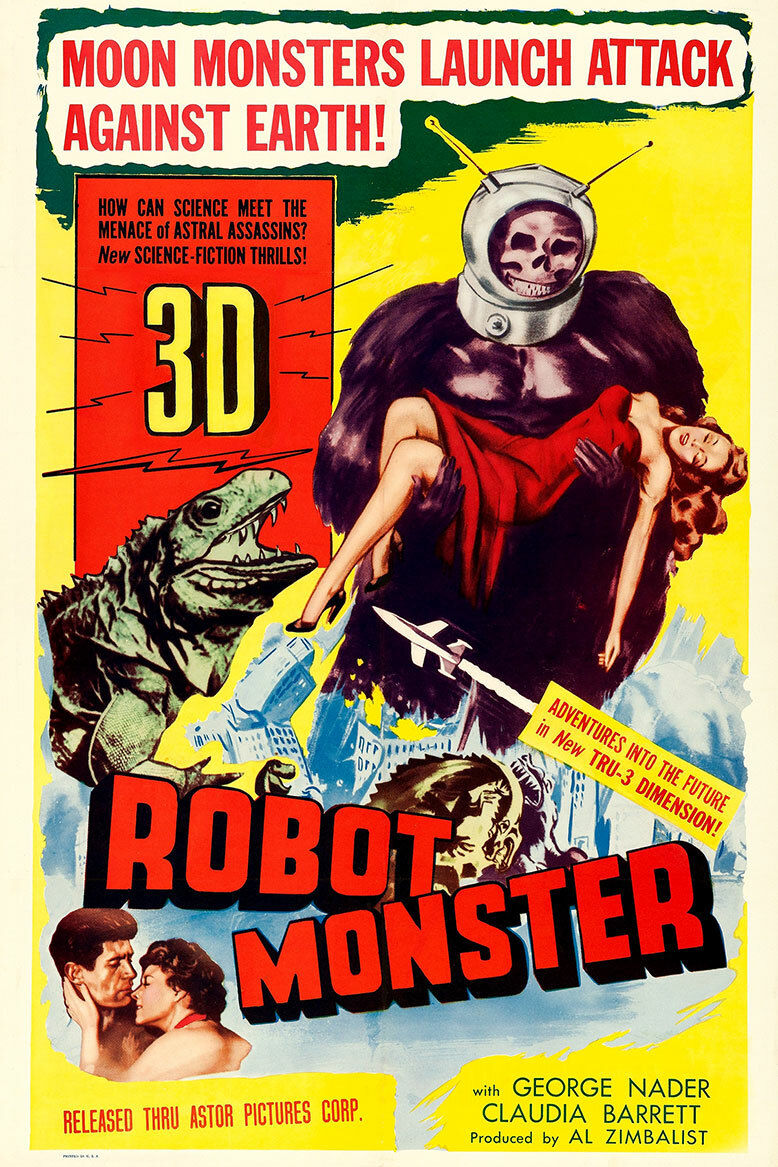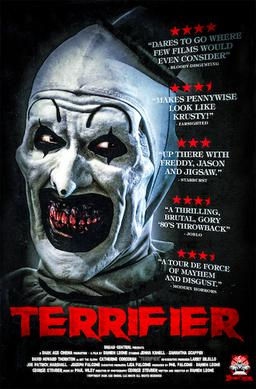Robot Monster (1953) review
- Jeremy Kelly
- Oct 1, 2023
- 6 min read
Happy October, everyone! We’re back again for my 12th year of reviewing horror movies all throughout the month. 31 days, 31 movies, we’re going again.
Normally, I spend the month going over some of my favorite movies of the genre; but this year, we’re doing something very different. I’m branching out and looking over some all-time stinkers; okay, not exactly, but they’re all films that have some sort of camp or cult reputation. Some are so bad they’re good, some are just bad but still worth talking about, and some are so outlandishly bad they have to be seen to be believed. Because damn it, even lousy cinema deserves some attention now and again. Now while I’m still doing my usual ratings out of 10, these will be more on a scale of how much I enjoy the movie, rather than objective quality; you might say I’m grading on a curve, but so be it.
Alright, I’m busy enough as it is, so let’s get right to it; first movie, go!
1. Robot Monster (1953)
Directed by: Phil Tucker
Produced by: Phil Tucker
Screenplay by: Wyott Ordung
Starring: George Nader, Claudia Barrett, George Barrows

It’s hard for me to zone in on a time period to begin this marathon, because campy films aren’t really my area of expertise; I don’t often go looking for films I know are bad. But the 1950s seem like the right decade; this was known as the golden age of science fiction, so you had all sorts of films about aliens, giant monsters, atomic disasters and the like. I’ve already reviewed some of the great ones like “The Thing from Another World,” “Them!” and “Godzilla.” But let’s go digging for some bottom-of-the-barrel variety; today’s film is “Robot Monster,” a movie shot in four days for an estimated $16,000. It’s about an alien robot called Ro-Man (George Barrows) who’s trying to eliminate the last of humanity; it’s as cliché as it gets. The plot is incoherent, the pacing is inept, and the themes are way more profound in theory than execution; but it’s harmless, jarringly silly nonsense.
Taking place in a desert area, we see a family that has survived the alien invasion: a professor (John Mylong), his wife (Selena Royle), their son Johnny (Gregory Moffett), their daughters Alice (Claudia Barrett) and Carla (Pamela Paulson), and the professor’s assistant Roy (George Nader). The professor has somehow created a serum that’s made them all immune from Ro-Man’s Calcinator death ray, which has killed everyone else in the world. There’s apparently a whole empire of these robot monsters that want to take over Earth so the Earthlings don’t take over them…makes sense to me. Anyway, Ro-Man’s being ordered by his superior the Great Guidance (Barrows) to finish the job, but he needs a way to counter their immunity; and to complicate matters, he develops a “King Kong”-like attraction to Alice, so now struggles with his conviction to complete his mission, as the family ponders any means to appeal for survival.
Okay, the first thing I have to mention is the look of Ro-Man; as you can see from these images, it’s basically a gorilla suit with a space helmet. Apparently, there wasn’t a budget for a robot costume, so writer/director Phil Tucker, just 25 years old at the time, asked his friend George Barrows, who had his own gorilla suit that he had donned opposite Tarzan and Abbott and Costello. He would do so many more times on TV shows like “The Incredible Hulk,” “The Jackie Gleason Show” and “The Beverly Hillbillies.” Ro-Man is actually more like the main character for how often he’s featured, typically shown gesturing with his arms as he speaks in the voice of radio veteran John Brown, and I have to admit, the sight of him shaking his fists at Johnny while he runs away is pretty hilarious.

The human characters are all pretty generic, and the actors don’t do them any favors; the only performance that actually stands out as solid is Selena Royle, who’s surprisingly believable as the mother. This was one of Royle’s last roles, as she was blacklisted after being branded a Communist sympathizer by the HUAC. Anyway, there are a lot of interactions between Roy and Alice, featuring such nuanced dialogue as “You’re either too beautiful to be so smart or too smart to be so beautiful.” Granted, some of the lines are intentionally funny, and there actually are potentially interesting concepts, like free will and what it means to be human; but it never really amounts to anything substantial.
Mostly, we’re just marveling at how random everything is; roughly halfway through the movie, Roy takes his shirt off for no apparent reason, and never puts it back on. There’s a whole development about Alice leading an effort to contact a pair of space pilots aboard a rocket ship; but it’s resolved in about three minutes, and we never even see the pilots as the ship is destroyed. Oh, and there’s a bubble machine Ro-Man has in his cave lair; it has no purpose whatsoever. There’s also just a strangely lax attitude about what’s happening. One long sequence with Roy and Alice hiding from Ro-Man is staged more like a silent romantic comedy; they’re performing these cute, goofy acts with the music playing over their dialogue, yet it’s randomly intercut with shots of Ro-Man walking ominously. They suddenly realize they’re in love, and ask the professor to marry them; he proclaims it the social event of the year, as they conduct an entire ceremony, and then they go off to make out next to a bush. Does anyone actually care about what’s going on in this story?
On the other hand, how can we care when they obviously don’t have a budget to show any credible threats? Any scenes of destruction are basically stock footage, with the most egregious examples being giant lizards from “One Million B.C.” and stop motion triceratops from “Lost Continent.” However, the location is worth mentioning; the movie’s filmed in Bronson Canyon, which is right near Griffith Park in Los Angeles. It’s one of the most iconic shooting locations in the world; countless films and TV shows of all genres have been shot here going back over 100 years. It’s probably most famously recognized as the entrance to the Batcave in the 1960s “Batman” series.

Keeping with the craft discussion, I was surprised to see the music is composed by Elmer Bernstein, who went on to earn 14 Oscar nominations and work on classic films like “The Ten Commandments,” “To Kill a Mockingbird” and “Ghostbusters.” Some of the musical tracks here are good, but many are just so out of place related to the action. In multiple scenes, there’s either a whimsical or dramatic piano score, but it’s over rather static shots of characters just walking across a dirt terrain. It’s incredible how so many of these techniques and ideas don’t mix. I should probably mention by now that the events of the movie are revealed to be a dream, as early on we see Johnny falling during a lightning storm after a family picnic, and then he wakes up towards the end, only for the film to tease us with a “Or was it a dream?” trick before the credits. It’s at least better than making it a last-minute twist, which I hate, but it’s still just a lame way to frame your movie; still, I guess it’s simply not worth complaining about.
For as imprudently as this film is put together, I kind of wish it was a little more fun to watch; it’s actually pretty hard to follow because the events are overall dull. Occasionally, there might be something to point and laugh at, but there are much more entertainingly bad movies out there. However, it is worth noticing the impact and talent concerning certain aspects of the trade; it just doesn’t come together for a feature production. Tragically, Tucker suffered the worst of it, as he attempted suicide later in the year “Robot Monster” came out due to depression stemming from the poor reception, disputes with the distributor who had allegedly refused to pay him, and subsequent inability to find work. Thankfully, he survived, and would actually find new life as a decent film editor by the 1970s. This is considered one of the great “so-bad-it’s-good” movies, but I think it’s only bad enough to be mildly forgettable.
My rating: 4.5/10





Comments